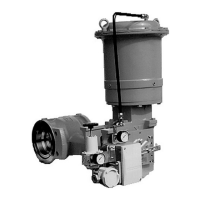
Do you have a question about the Azbil FloWing VFR and is the answer not in the manual?
| Brand | Azbil |
|---|---|
| Model | FloWing VFR |
| Category | Control Unit |
| Language | English |
Check model number, size, rating, materials, and other specs on the nameplate against ordered specifications before installation.
Procedures for installing the valve in the piping system, including bolt usage, alignment, and ensuring correct flow direction.
Steps for verifying no leaks, checking for loose parts, and lubricating the valve after installation.
Provides a cutaway view and explains the components of the valve body section, including valve plug, seat ring, and trim parts.
Detailed steps for dismantling the valve body section, including removing packing, stem, plug, and seat ring.
Step-by-step instructions for reassembling the valve body section after disassembly or maintenance.
Explains the VR Actuator as a pneumatic and spring type diaphragm motor for rotary control valves and its components.
Procedures for adjusting the actuator action after overhaul or if it starts to shift, involving the turnbuckle and pressure regulator.
Step-by-step guide on how to safely detach the actuator from the valve body, starting with positioner removal.
Detailed instructions for taking apart the actuator for parts replacement or servicing, focusing on diaphragm and piston.
Instructions for reassembling the actuator, emphasizing correct order and lubrication of components like the piston and diaphragm.
Procedures for reattaching the actuator to the valve body in reverse order of removal and subsequent adjustment.
Explains the function of the manual device (handwheel) as both a limit stopper and manual control for the valve.
Steps to set the manual device for automatic operation, including releasing and locking the handwheel.
How to operate the valve manually using the handwheel and securing it in position.
Method for using the handwheel as a limit stopper for maximum or minimum aperture control.
Introduction to the intelligent SVP, its connectivity, and electrical adjustment capabilities for control valves.
Details the functions and capabilities of the Smart Valve Positioner (SVP) for control valve applications.
Procedures for detaching and re-attaching the SVP from/to the valve, including bolt removal and component handling.
Guidance on adjusting the SVP, referring to external manuals for specific model details.
Information on maintaining the SVP, directing users to specific manuals for details.
Guidance on troubleshooting issues with the SVP, referencing external manuals for detailed solutions.
Introduction to the pneumatic valve positioner for the VFR actuator, listing its main components.
Details the pneumatic valve positioner's function in accurately positioning the valve plug based on controller signals.
Explains the force balance mechanism used by the pneumatic positioner to control valve operation.
Describes the function of the bypass cock for switching between positioner operation and direct supply air control.
Guidance on selecting and installing appropriate cams for desired linear or equal-percent flow characteristics.
Procedures for removing and reinstalling the pneumatic positioner, including disconnecting piping and handling bolts.
Detailed steps for adjusting the pneumatic positioner after installation or replacement, covering zero and span settings.
Operating precautions and notes on cleaning restrictions for maintaining the pneumatic positioner's performance.
A table outlining common symptoms, causes, and actions for troubleshooting the pneumatic valve positioner.
Instructions for changing the installation orientation of the actuator on the valve body.
Steps to modify the valve's action (direct/reverse) by changing the clamp and fork positioning.